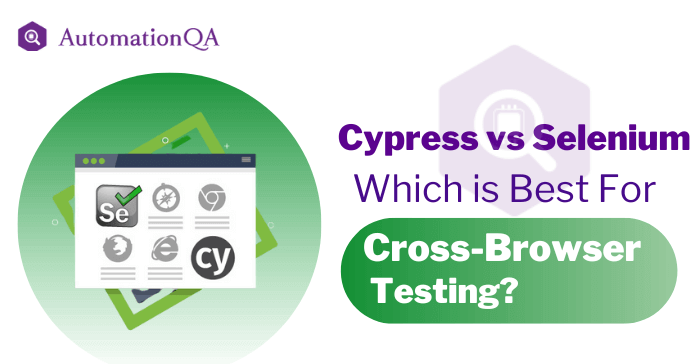
Cypress vs Selenium, which is the best cross-browser automated testing platform for you? What should be the selection criteria for delivering a successful project?
If these questions also bother you, then you are not alone. This blog will help you find the answer to this question by comparing the key features of Cypress and Selenium head-to-head.
Providing a seamless user experience is one of the biggest challenges a web developer or a tester faces. Today, more than one dozen web browsers are available, each with its rendering engines, which causes variation in the display. Consequently, making cross-browser testing an integral part of the software development process.
Using the right tool can produce satisfactory results and financial burdens on businesses. Therefore, Selecting the right tool is crucial for web automation. Therefore, it is essential to consider different options like Selenium Web Automation or Cypress automation and evaluate your requirements before making any decision.
What is Selenium?
Selenium is an open-source, cross-platform automation testing tool developed in 2004 for a web application. Today, testers widely use this framework for testing. Selenium supports different operating systems like Windows, Linus, and OS X. This gives the developer flexibility to test their application on these operating systems.
You can use Selenium to simulate various practical conditions to check the application’s stability. With a wide range of features like multi-browser support, parallel testing, and support for mobile testing, Selenium is a powerful tool to streamline the testing processes. However, the decision between Cypress vs Selenium ultimately depends on the user’s testing needs and preferences.
Advantages of Selenium
- Selenium is an open-source software meaning that you do not require any costly license to use this platform.
- Selenium supports many programming languages like Python, C#, Ruby, Kotlin, PHP, and Swift. So, the QA person does not have to learn any new languages to automate their testing.
- Being an open-source platform, the developer can quickly integrate any third-party tools for development and reporting.
- By integrating with Selenium Grid, the platform also supports the execution of the parallel test.
- Selenium WebDriver is designed to utilize minimal computing power and RAM while executing scripts.
Disadvantages of Selenium
- You cannot upload files in Selenium.
- It does not allow you to test image-based applications using the platform.
- It needs great expertise and resources to work on the platform.
- Lacks online support.
What is Cypress?
Cypress framework is powerful and user-friendly, letting the developer write an efficient and practical script to test applications. It is an E2E testing framework that employs JavaScript to automate tests. Cypress does not rely on Selenium compared to other testing frameworks. The Cypress testing tool is a front-end testing tool popular among developers and testers.
Advantages of Cypress
- Cypress has several advantages for developers, such as simple setup due to pre-defined libraries and dependencies, quick test result execution, automatic scrolling that shows the whole view of every element before performing a given operation, and the capability to take screenshots while test runs are in progress.
- Cypress does not require implicit or explicit wait commands in test scripts because it waits for statements and instructions automatically before moving on.
- The program operates directly on the browser without further software installation and has excellent documentation.
- Cypress tool includes essential debugging tools and takes a snapshot at each test step, making it simple to inspect the condition at any point in the test script.
Disadvantages of Cypress
- Cypress supports only two development languages, JavaScript, and Typescript.
- It does not directly support using multiple windows or tabs.
- Cypress tests do not enable cross-domain scenarios.
- Developers might need to install extra third-party plugins to access key functionalities like XPath or reporting.
Cypress vs Selenium- The best tool to Choose?
Cypress and Selenium are two well-liked web automation testing tools. However, they serve different purposes. Cypress testing is an excellent choice if you are experienced in JavaScript and require a solution that conducts automation testing on a local system. It is a growing tool that may be used for testing websites automatically.
On the other hand, Selenium is the way to go if you want the code to work across several browsers and operating systems. While Cypress is a developing technology, Selenium testing is well-known in automation testing. Thus, it can be challenging to say which tool is the best without understanding the needs of the tester.
Conclusion
Though Cypress automation services have recently gained popularity, Selienum has led the test automation market for a while. These testing tools offer a user-friendly interface and various features that make the job of a QA analyst easy.
Therefore, before selecting any tool, a tester must clearly define his purpose. He must also evaluate both tools based on his requirements. The field of automation testing has evolved a long way, and it will be interesting to see the impacts of these testing tools soon. However, if you had to choose between Cypress vs Selenium, which would you go for?
